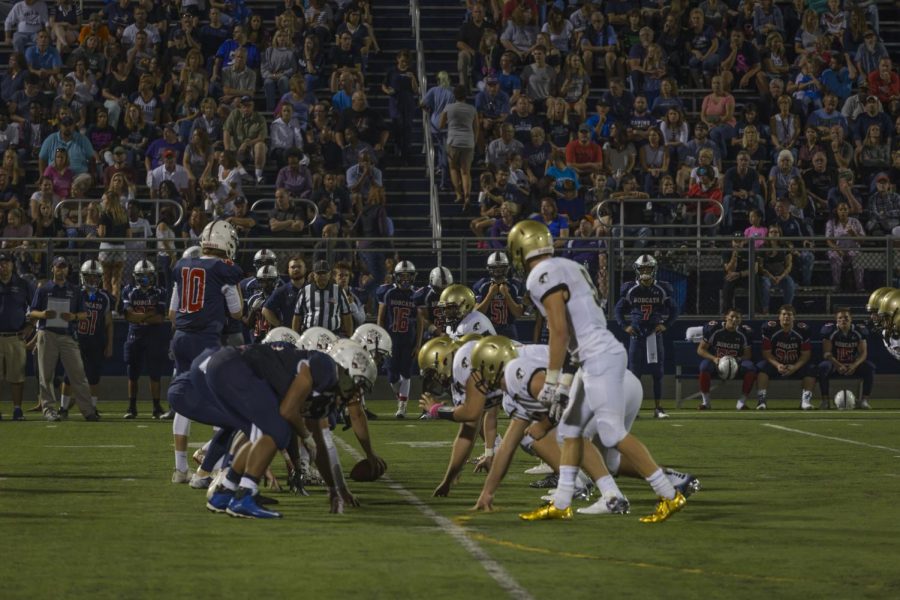Facing the fans
The clock ticks down. Time is running out. You can barely hear your coach screaming in your ear over the deafening roars of the crowd. Your heart is beating out of your chest, and your body is exhausted, but everyone is depending on you. You better not mess up.
High school athletes are put under enormous pressure to perform well. Their coaches, parents, teammates, and the swarm of fans are counting on athletes to perform their best.
According to junior football player Ayo Bodison, games with large attendance put the most pressure on athletes. “The most nervous I have ever been was probably [against] Bel Air because I was playing in front of all my friends and family. I felt like I had to prove myself,” he said.
Although crowds can be distracting, players tend to enjoy the heightened atmosphere. “In some ways, large crowds make things chaotic, and [in] some ways it makes me more excited,” Bodison said.
Unlike Bodison, sophomore field hockey player Mackenzie Hopkins feels no pressure from her family, and the crowds do not affect her. “I’m used to playing in front of my parents, and the crowds never bother me,” she said.
Nerves, however, are not reserved for exterior influences. Oftentimes, athletes stress themselves out by setting demanding goals. “I always want to do my best, and if I make a mistake it will bother me until the next week,” senior cross country runner Rosemary Gillam said.
Many athletes have developed a routine to help calm their nerves prior to games, such as a repeated warm up, listening to music, or pre-game speeches. Hopkins believes that her team’s routine helps to calm nerves before games. “We run through warmups before games. We always stretch and sometimes work on passing. Doing this before all my games helps calm me down,” she said.
Gillam agreed that having a warmup to begin with before any match helps calm her nerves.“I always do a half-mile warmup and do a thorough stretch starting with my hip flexors and ending with my calves and ankles,” she said.
For many players, once the game begins, the nerves quickly disappear. Their minds tune out all the distractions and they focus on the game at hand. “I just get excited and focused, really focused,” Bodison said.
In the end, nerves are something every player has to deal with differently. No matter the ritual, every athlete who wants to be successful has some ways of handling it, whether that way is distracting themselves or tackling the problem head-on.
Matt Foulk is a Sports Editor of The Patriot and jcpatriot.com.
Coach teaches meditation
Varsity baseball coach Darrion Siler and 30 players sit together. They close their eyes and inhale a breath of fresh air and hold it. Their mind focuses on the air flowing into their lungs, and their muscles relax as stress leaves their body. Eight seconds pass, and they exhale.
Siler introduced techniques that are often used in meditation to the baseball team this fall. “One of the things we talk about is mindfulness. Being present in the moment is an important part of sports performance,” Siler said.
According to Siler, being “present in the moment” means to focus on the task at hand and forget about what has happened in the past. Siler preaches the importance of letting things go and moving on to the present moment to his players.
Siler believes athletes should concentrate on the sport they’re playing, instead of worrying about the past, “Meditation practices can help you stay focused on what [the task] is and what you are truly trying to do, as opposed to worrying about external forces and letting things you can’t control [bother] you,” Siler said.
Siler teaches the baseball team some of the same techniques that sports psychologist Dr. Ken Ravizza uses with his athletes. Ravizza works with several professional sports teams, including the 2016 World Series champions, the Chicago Cubs.
According to the Chicago Tribune, before every practice or workout, Ravizza’s athletes partake in a five-minute meditation exercise. They focus on their breathing and move their attention to different parts of the body.
Similarly, the baseball team begins fall practice by gathering in a tight circle and taking five minutes to do breathing exercises. They begin by feeling their feet in their cleats, recognizing they’re in the present moment.
Siler began teaching junior pitcher and outfielder Ryan Ishak meditation techniques this fall. Ishak has already begun to see results, “It has helped me stay focused on the tasks that I am doing,” he said.
While Siler is teaching meditation practices for baseball, they’ll also reap the rewards off the field. “Meditation can help you with tests, relationships, and life in general,” Siler said. He believes meditation helps people become more self-aware.
While Siler knows the benefits from the breathing exercises he’s teaching his players, he understands that meditation does not dispel all nerves. “[The breathing exercises] are not a magic pill. It’s not all of a sudden now that you have a mental practice that you’re always in a mellow, relaxed state,” he said.
Yogi Berra, an 18-time MLB All-star, understood the importance of the psychological aspect of the game.“Baseball is ninety percent mental. The other half is physical,” he said. Siler wants his players to practice the mental game just like they practice the physical part of the game.
Chris Roberts is a Sports Editor of The Patriot and jcpatriot.com.

